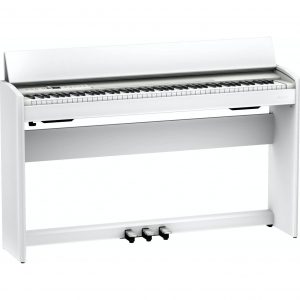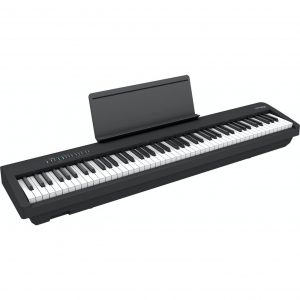Yamaha P45
$110.99
The Yamaha P45 digital piano delivers authentic piano sound and touch in a compact and stylish design, perfect for both beginners and experienced musicians.
Compare
Description
Yamaha P45 Piano – A Perfect Blend of Sound and Style
In today’s world, the piano is one of the most renowned musical instruments that has always been an essential part of musical settings. Either you are a pianist, music lover, or a beginner, the demand for the piano is continuously on the rise. However, finding an ideal piano that delivers quality sound and style can be challenging, as there are plenty of options available in the market. One of the most popular models of Yamaha, the Yamaha P45, is a perfect blend of sound and style and is widely appreciated among musicians worldwide.
The Yamaha P45 digital piano is a single-home keyboard that is packed with plenty of features that make it a great choice for the pianist. The Yamaha P45 is designed to mimic the feel of an authentic acoustic piano by offering weighted keys that give a natural, responsive touch that requires less force to play. The keyboard features 88 keys that are touch-sensitive, meaning the keys respond to the amount of pressure put on them. Besides that, the Yamaha P45’s keyboard is designed to offer a quiet playing experience, so you can play even in silent places without disturbing anyone.
Another significant advantage of the Yamaha P45 piano is that it delivers a realistic sound with a clear and authentic tone, making it ideal for both practicing and performing. It features Advanced Wave Memory (AWM) sampling, a technology that captures the sound of real acoustic instruments, giving the P45 a rich, dynamic sound. To add to its versatility, the Yamaha P45 features ten different voices, including piano, electric piano, organ, and others to suit your playing style.
In addition to sound quality and keyboard responsiveness, the Yamaha P45’s design makes it an excellent piece of digital furniture that would complement any space at home, studio, or stage. The Yamaha P45 weighs just 25 lbs, making it lightweight and easy to move. It has a sleek and compact design that makes it easily portable and user-friendly. The compact design of the P45 also means it can easily fit into small spaces, making it convenient for users with limited area.
Ease of use is another significant advantage of the Yamaha P45. The digital panel is incredibly user-friendly, with easy-to-read functions that allow you to change tones, adjust the metronome, and change various settings according to your preferences. Additionally, the piano has a USB port, enabling you to connect your Yamaha P45 to your computer, making recording and playing your music simple and easy.
In conclusion, the Yamaha P45 digital piano is an ideal instrument for beginners and seasoned musicians alike. It combines innovative technology with high-quality sound and stylish design, making it a smart choice for both practicing and performing. The Yamaha P45 is a guarantee of quality, versatile, durability, and ease of use, and it remains one of the best digital pianos on the market today.
Yamaha P45 properties
| Product name |
P45 |
| Brand |
Yamaha |
| Type |
Keyboard Instruments |
| Keyboard Instrument |
Stage and Digital Piano |
| Keys |
Yes |
| Number of Keys |
88 pcs |
| Key Functions |
Dual Layer, Touch Sensitive |
| Pre-Programmed Effects |
Yes |
| Speakers |
Yes |
| Connections |
Headphone, USB |
| Colour |
Black |
| Power Supply |
Electrical Cable to Wall Socket |
Frequently Asked Questions:
How do I connect my Yamaha P45 to my computer for using it as a MIDI controller?
To use the Yamaha P45 keyboard as a MIDI controller for your computer, follow these steps:
1. Make sure that you have installed the necessary drivers and software for the Yamaha P45 on your computer. If not, download them from the official Yamaha website or from the user manual provided by Yamaha.
2. Connect the USB cable provided with the keyboard to both the keyboard's USB port and a free USB port on your computer.
3. Make sure that your computer recognizes the Yamaha P45 as a MIDI input device. To do this, go to the Control Panel > Hardware and Sound > Devices and Printers. In the list of devices, you should see "Yamaha P45" or something similar.
4. Launch your preferred Digital Audio Workstation (DAW) software, such as Ableton Live, FL Studio, Logic Pro X, etc., on your computer.
5. Open the MIDI preferences or settings in your DAW. Here you should see the Yamaha P45 listed as a possible MIDI input device. Select it and make sure that it is enabled for both receiving and transmitting MIDI data.
6. Now, you can start using your Yamaha P45 keyboard as a MIDI controller in your DAW software. You can play notes, control knobs, sliders, and buttons on the keyboard to manipulate sounds, effects, and parameters within your DAW.
Remember that not all features of the Yamaha P45 may be recognized by your DAW, but its basic MIDI capabilities should work fine. If you have any issues with the connection or functionality, refer to the user manual for more detailed information or contact Yamaha's customer support for assistance.
How does the Yamaha P45's Graded Soft Touch keyboard action differ from other digital pianos in its price range, as described by Yamaha's website?
According to Yamaha's website, the Yamaha P45's Graded Soft Touch keyboard action is different from other digital pianos in its price range because it features a graded response, which simulates the sensitivity of the keys on an acoustic piano. This means that the lower notes have a heavier touch and require more force to play, while the higher notes are lighter and easier to play. Additionally, the keyboard action is designed to provide a more responsive and authentic feel when playing pianistic passages, such as staccato or legato. Overall, Yamaha claims that this graded response feature helps to improve the playing experience for users of all skill levels.
What are the key features of the Yamaha P45 digital piano, specifically regarding its stage and digital capabilities?
The Yamaha P45 digital piano boasts several notable features in both its stage and digital capabilities. On the stage side, this instrument offers a Graded Hammer Standard (GHS) keyboard that provides a realistic and authentic feel to the touch, similar to that of an acoustic grand piano. Additionally, the P45 features Yamaha's proprietary AWM Stereo Sampling technology, which delivers rich and immersive sound quality with detailed instrument samples recorded in world-class recording studios. In terms of digital capabilities, the P45 comes equipped with a variety of functions that expand its versatility as both a practice tool and a performance instrument. The Duo mode allows users to connect two instruments of the same model and practice side by side with an accompaniment track, while the USB to Device feature enables users to record their performances directly to a thumb drive for playback or further editing on a computer. Furthermore, the P45 includes 10 different voices, each with its own unique sound character, as well as a built-in metronome and a variety of accompaniment styles that provide automatic backing for the user's performance in real time. Overall, these features make the Yamaha P45 an excellent choice for both aspiring pianists and seasoned musicians looking to expand their digital piano repertoire.
How does the Yamaha P45's Graded Soft Touch keyboard technology contribute to a realistic piano playing experience?
The Yamaha P45 digital piano features Graded Soft Touch keyboard technology, which is designed to provide a realistic and authentic piano playing experience. This technology involves grading the keys in a way that replicates the feel of an acoustic grand piano, with lighter touch in the high registers and heavier touch in the lower registers. The result is a more natural and intuitive playing experience that allows pianists to better express themselves musically. Additionally, the Graded Soft Touch keyboard technology helps to prevent fatigue during extended practice sessions, as the lighter touch in the higher registers makes it easier to play quickly and with precision. Overall, this feature is a key factor in making the Yamaha P45 one of the most popular digital pianos on the market today.
What are the specific acoustic and digital sound adjustments that can be made to the Yamaha P45's onboard speakers, and how do they compare to using external monitoring equipment?
1. Sound Mode**: This is a general adjustment that allows you to switch between different sound modes. These modes can significantly alter the overall tone and balance of your sound. Common modes might include Grand Piano, Stage Piano, and Jazz Piano, each offering a distinct character and tonal range. Reverb/Delay**: The Yamaha P45 allows for adjustments in reverb and delay levels. These settings can add depth to your sound by simulating the way sound behaves in different environments or spaces. It's akin to playing in a large concert hall versus an intimate room. Master EQ**: This is where you can make more detailed adjustments to the overall tone of the sound. You might increase the brightness or warmth depending on your preference and the type of music you're playing. However, it's worth noting that while these adjustments can be very helpful, they may not fully compensate for limitations in the onboard speakers themselves. Pedals**: Adjustments related to the sustain and sostenuto pedals can also affect the overall sound quality. These are more about how the sound interacts with each other rather than altering the tone directly but are crucial for a realistic performance experience. Now, comparing these adjustments to using external monitoring equipment:
- **Sound Quality**: External speakers or monitors can offer better sound quality compared to onboard speakers in terms of clarity and depth. This is because they're typically designed specifically for music production or live performances, providing more detailed highs and deeper lows. Adjustments**: With external monitoring, you often have access to a wider range of adjustments that can be made through the monitor's settings or even external equalizers. These offer much finer control over the sound than what's available on the P45 itself. Connectivity Options**: External speakers usually come with more robust connectivity options (like XLR/TRS inputs) compared to the onboard speaker outputs, offering a wider range of compatibility with professional audio equipment. In summary, while the onboard speakers of the Yamaha P45 offer an excellent way to experience its sound without needing additional equipment, external monitoring can significantly enhance the quality and customization of your sound. External speakers often provide better sound clarity and depth, along with more flexible adjustment options and robust connectivity.
Before you buy Yamaha P45






Reviews
There are no reviews yet.